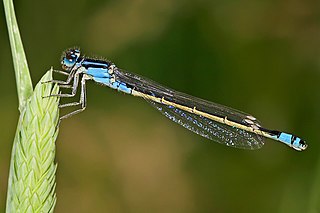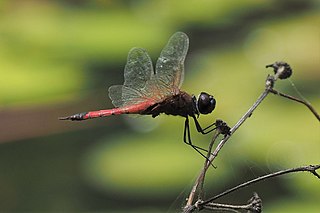
The skimmers or perchers and their relatives form the Libellulidae, the largest dragonfly family in the world. It is sometimes considered to contain the Corduliidae as the subfamily Corduliinae and the Macromiidae as the subfamily Macromiinae. Even if these are excluded, there still remains a family of over 1000 species. With nearly worldwide distribution, these are almost certainly the most often seen of all dragonflies.

Diplacodes is a genus of dragonflies in the Libellulidae family. They are commonly known as perchers. Their colours range from the totally black body of the African Diplacodes lefebvrii, the lovely pale blue of India's Diplacodes trivialis, to the intense red of the Asian–Australian Diplacodes haematodes.

Brachydiplax is a genus of dragonflies in the family Libellulidae. They occur in Asia from India to China and Southeast Asia, and New Guinea to Australia.

Aethriamanta is a genus of dragonflies in the family Libellulidae. Species of Aethriamanta are found in Madagascar, through Southeast Asia, Indonesia, New Guinea and northern Australia.

Agriocnemis is a genus of damselfly in the family Coenagrionidae. Agriocnemis is distributed widely across Africa, South-east Asia, Indonesia, Australia and islands in the Pacific. They are small insects, commonly known as wisps.

Ceriagrion is a genus of damselfly in the family Coenagrionidae. Species of Ceriagrion are small to medium size, generally brightly coloured damselflies. They are found across the Old World, Africa, Asia and Australia.

Gynacantha is a genus of dragonflies in the family Aeshnidae. The females have two prominent spines under the last abdominal segment. This gives the genus name and the common name two-spined darners; they are also known as duskhawkers.

Ischnura is a genus of damselflies known as forktails in the family Coenagrionidae. Forktails are distributed worldwide, including various oceanic islands. The males have a forked projection at the tip of the abdomen which gives the group their common name.

Pseudagrion is the largest genus of damselfly in the family Coenagrionidae, with over 140 species. Its range includes most of Africa, much of Asia, and Australia. Africa holds most of the diversity with almost 100 species. It has occupied most of the freshwater habitats in its range, and dominates damselfly communities in habitats as different as desert pools, equatorial rainforests and montane streams.

Teinobasis is a genus of damselflies in the family Coenagrionidae. Species occur in south-eastern Asia, Indonesia, Solomon Islands and Micronesia; one species, Teinobasis rufithorax, is found in Australia.

Tramea is a genus of dragonflies in the family Libellulidae, the skimmers and perchers. Species of Tramea are found in tropical and subtropical regions around the globe. They typically have colored bases to their otherwise translucent hindwings. In particular when they fly, this creates the impression of their carrying bags at the start of their abdomens. They are known commonly as saddlebags or saddlebags gliders.

Neurothemis is a genus of dragonflies in the family Libellulidae. They are found in India, Asia, Australia and the Pacific region. Most Neurothemis species are red in color.

Anax is a genus of dragonflies in the family Aeshnidae. It includes species likesuch as the emperor dragonfly, Anax imperator.

Neurobasis is a genus of damselflies belonging to the family Calopterygidae. They are found from India, through south-east Asia, Indonesia and New Guinea.

Tramea transmarina, known as the red glider or northern glider, is a species of dragonfly in the Libellulidae family. The type locality for Tramea transmarina is Fiji, but subspecies are found in the islands of the Pacific, north-eastern Australia and Southeast Asia.

Agrionoptera insignis allogenes known as the red swampdragon is a subspecies of dragonfly in the family Libellulidae. It is found in Australia, New Guinea, the Solomon Islands and possibly New Caledonia.

Agrionoptera insignis is a species of dragonfly in the family Libellulidae. It is native to much of eastern Asia and Oceania, occurring as far north as Japan and as far south as Australia. It is common in most of its range. The circumscription of the species is not entirely clear, so if the species is rediscribed, its status may change. Common names include grenadier.

Agrionoptera longitudinalis is a species of dragonfly in the family Libellulidae.


















